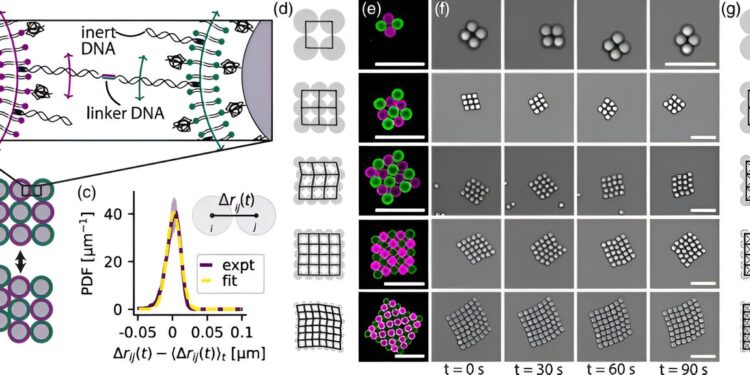Flexible colloidal square networks. (a) A schematic overview of the binding mechanism. (b) A schematic example of a floppy mode deformation in a 3 × 3 square lattice. (c) The distance distribution between two particles. (d) Time-averaged particle positions as measured in experiments, where the bond network is shown in black. (e) Confocal images of n × n square arrays. (f) Brightfield snapshots of the same networks taken 30 seconds apart. (g) Spring networks used in the theoretical description. Credit: Physical Examination Letters (2024). DOI: 10.1103/PhysRevLett.132.078202
Daniela Kraft’s group succeeded in creating a network of microparticles that was both strong and completely flexible. It may seem simple, but they are the first in the world to achieve it. This achievement represents a real breakthrough in soft matter physics. The study is published in Physical Examination Letters.
PhD candidate Julio Melio studies microscopic and flexible networks and it’s not an easy task. In nature, these microarrays are found in gels, polymers, or the cytoskeleton of your body’s cells. “These materials are flexible because of what we call soft modes, flexible states,” Melio explains.
“We don’t really know how temperature affects these states. It’s too complicated to study this in biological systems, so we created an array of microscopic spheres, colloids, in the laboratory. The simplest system is an array square. It can deform into a shape similar to a diamond, for example.
Clever technology for flexible connections
The researcher buys silica colloids and coats them with lipids. Then he creates a DNA link to connect the spheres. “We use two types of DNA strands that can attach to each other and put them on colloids. These can then bind to each other, but not to another colloid of the same species. The particularity of these DNA bonds is that the linked particles can move relative to each other. The network is therefore flexible.
Then begins the difficult work of bringing the beads into the desired structure. It’s quite a challenge, explains Melio. “You take one colloid with what’s called an optical tweezer, a laser, and you put it in contact with a second one. That’s how you build the network one by one.” However, the system is extremely sensitive, so at the slightest change in circumstances you get qualitatively bad spheres sticking together. “And then the system loses flexibility,” says Melio.
The first time, it took the Ph.D. candidate nearly three quarters of a year to create a perfectly square grid of five by five colloids. “Today, fortunately, I can do it much faster,” he says. This makes the Kraft Group the first in the world to build a large microstructure in such a controlled manner without losing flexibility.
Potential applications: metamaterials and microrobots
Researchers have already gained new knowledge that helps better understand soft modes in microgrids. The larger the lattice, the more likely it is to be in a square state rather than a diamond state. Larger structures also shear better: they deform more easily under the effect of a shear force than smaller variants.
This is interesting for developing new metamaterials, whose properties depend on the structure. For example, how it reacts to pressure or how it can fold up. But above all, Melio hopes to be able to find a way to remotely control the deformation of the microgrid.
“You would then have the basis of a microrobot. These are used, for example, in biomedical applications, like operations. Of course, I’m not that far yet. I’m currently experimenting with making the colloids magnetic to see if they can be controlled from the outside in this way. It would be really nice if I could achieve this before finishing my doctorate,” says Melio.
More information:
Julio Melio et al, Soft and rigid normal modes in soft colloidal square lattices, Physical Examination Letters (2024). DOI: 10.1103/PhysRevLett.132.078202
Provided by Leiden University
Quote: A first in the laboratory: A tiny network of microparticles that is both solid and flexible (February 15, 2024) retrieved on February 15, 2024 from
This document is subject to copyright. Apart from fair use for private study or research purposes, no part may be reproduced without written permission. The content is provided for information only.



